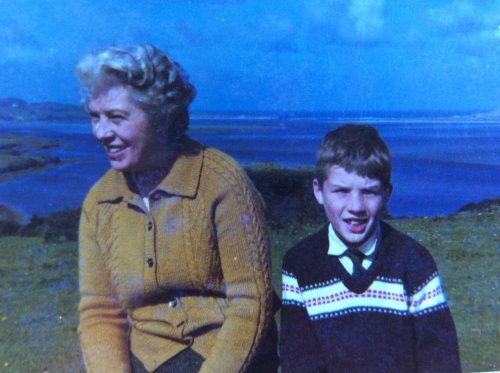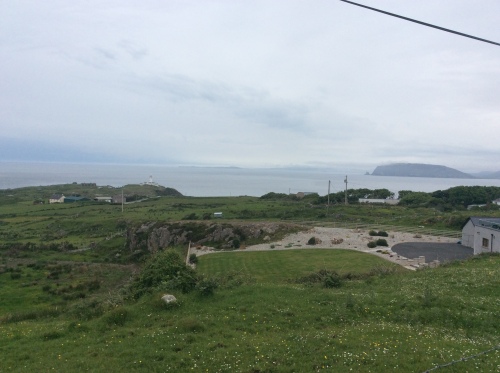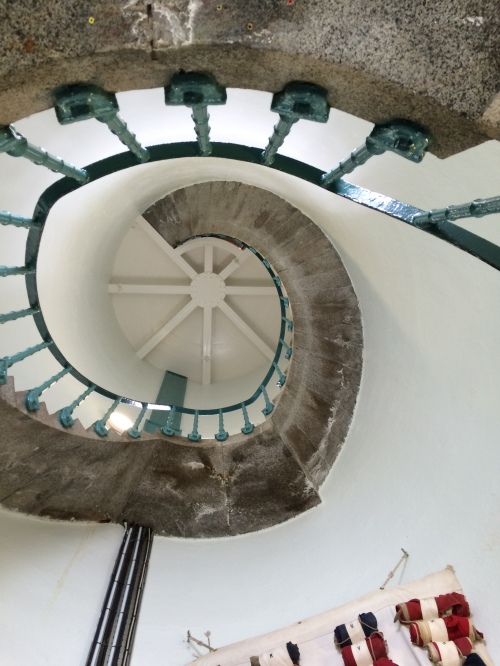On this day, February 7, 1919, which also fell on a Tuesday, our grandparents, James Gallagher and Mary (Nee Friel) welcomed their second child into the world. Eileen Ann was born in Glenswilly, the younger sister of the then 20 month old May Isabella. Their father was at that time a National School teacher in Templedouglas near Churchill, County Donegal. Our Aunt Eileen Ann, was named after her maternal grandmother and her mother’s younger sister, both of whom were Annie.

Three Gallagher children with their Aunt Annie and three McAteer cousins in Fanad, probably in the late 1920s. Aunt Eileen (‘Di’) is on the extreme left with Aunt May on the extreme right (thesilvervoice)
After Templedouglas our grandfather moved to Ballyheerin in Fanad where he taught for a while and he eventually got a school in Carrigart.
This photo is of our father and Aunt Eileen on the right. Unfortunately we don’t know who the other lady is. This was probably taken in the 1930s

Dad with older sister Eileen (on the right) in Carrigart (and photobombing doggie) (thesilvervoice)
In 1945 ‘Di’ married Hugh Coyle of Milford County Donegal. A gentle giant, lovely soft-spoken man

The tall dark and handsome Hugh Coyle of Milford and Di were married in 1945.(thesilvervoice)
Hugh and Eileen began married life in her family home in Carrigart. Their first child arrived in 1946. Sadly little baby Mary Patricia died when only a few months old, probably as a result of a colon blockage. For all of her life, Di kept a little piece of lace or gown that was associated with their little daughter. Interestingly her death was never registered (nor indeed was the death of our brother who also died as a child in 1959). She is buried alongside our grandfather, our brother and our parents in Carrigart. Hugh and Eileen eventually moved to Letterkenny and Derry before finally settling in Glasgow with their other two children.
Aunt Eileen was always known to us as ‘Di’ as we could not pronounce her name when we were younger. She was also my godmother. This was done by proxy as she was not actually present at my christening. Hers was always the first birthday card to arrive and we kept up frequent correspondence throughout her life. Her letters and cards remain among my most treasured possessions. Every summer she and her family would travel back home to Carrigart for the annual holidays on the ‘Glasgow Fare’. How we loved to see them descend from the Swilly Bus! She would bring tins of roasted peanuts and Scottish oat cakes and Petticoat Tail shortbread and beautiful clothes from Marks and Spencer and all sorts of treasures that seemed extraordinary to us who lived in the country. Exciting outings to Tramore and Downings were guaranteed when she was in town. And how she cried when it was time to leave again and head by bus and boat back to Glasgow!
When I was aged 8 our father and I headed into Derry and caught the boat to Glasgow for a visit. I remember the captain giving me a Goldgrain biscuit that was warm to the touch because of the heat in his cabin; I remember being shown a submarine that sailed alongside us as we headed out of Lough Foyle; I remember being down in the very smelly hold of the ship with Dad and a man named Joe, a friend of my father, who was responsible for the well-being of the cattle who were being exported to Scotland and I remember getting locked into the lady’s toilet as I could not open the door and had to be rescued! Dad was not a bit pleased about that!

Pollokshaws Road with tenement flats
Glasgow was amazing to 8-year-old eyes with its (relatively) tall beautiful warm sandstone buildings. How I loved the sound of the clanging bells of trams as they swung around the corner of Eglinton Street! It was here that Di introduced me to my very first fish supper in a great fish and chip shop on the corner of Devon Street. We walked hand in hand in the fabulously named Sauchiehall Street and browsed the market stalls in the Barras in The Gorbals where she bought me a toothbrush. Hugh, Dad, my older cousin and I paid a cultural visit to the Art Gallery in Kelvingrove where we youngsters were reduced to uncontrollable tittering as only 8 and 9 years olds can be, at the first time ever sight of nudes!

Di at paternal family home in Mulnamina Glenties in the 1960s with our brother Damian. (thesilvervoice)
The thing that struck me most in later years was how hard it must have been for emigrants to these big cities to leave the rugged coastline and beautiful sandy beaches, the wide open fields edged with scented hawthorn and quiet country lanes for clanging trams, dark spiral staircases leading to flats one on top of another in the tenements of large industrial cities, with no private open spaces, only a shared courtyard in which to hang clothes to dry or watch children play. How hard must it have been to leave the grave of a little daughter behind in windswept Donegal? Although tenements provided very high density housing, the flats or apartments were very spacious inside with large high-ceiling rooms. Di used always laugh at a by-law that dictated that women could not clean the windows of these buildings, presumably in case they fell out onto the street below! But it was not all gloom and doom. ‘Up the stairs’ lived Bridget Connor (nee Coll) from Carrick in Carrigart, who was a cousin of Hugh’s. At every turn were Donegal people who had also taken the boat in search of better times. I remember Di telling me that you could always recognize Fanad men by the clothes they wore – a brown suit with particularly wide trouser legs! Still, it was a hard life. On Mondays Di loaded up her little pram with washing and headed out to the washouse to do the weekly family laundry as the flat did not have any clothes washing facilities. The notion of a wash house was strange to me as were other terms such as ‘close’ for the common entrance to a number of flats, and ‘the dunny’ for the basement at the bottom of the spiral staircase that led to the communal courtyard.
Di was a bit of a worrier but she had a lovely sense of humour and a wicked laugh. She was deeply religious, a fact that sustained her when Hugh died suddenly in the 1960s. She loved tweed and every year made sure to buy herself a skirt length of tweed when she came back to Donegal, to keep her warm and cosy during Scottish winters. She loved nice china and had a lovely collection of beautifully embroidered tablecloths. Pride of place was held by a blue willow pattern tablecloth given her by Mrs McCloskey of Carrigart on the occasion of her marriage in 1945. I often wonder whether this much treasured cloth has survived all these years. It was either discarded or given to charity after her death.
She died in December 1999. She and I had a very special relationship in spite of the distances between us. She above anyone else understood the challenging relationship between my mother and myself and made a huge difference to my life. She herself lived a gentle if challenging and often lonely life yet she never had a negative word to say about anyone.
We remember and celebrate her arrival into the world 98 years ago on this very day. The world is a better place for her having been here.




















 Heading away towards Portsalon I enjoyed a catch up with a cousin before taking the very spectacular Glenalla Road that runs along the cliffs and shores of Lough Swilly. At Ballymastoker Strand is a memorial to the crew of HMS Saldanha shipwrecked in a storm off Fanad Head on 4 December 1811 with 253 aboard. It is thought she went aground on rocks when attempting to make for shelter in Lough Swilly. There were no survivors and for weeks afterwards some 200 or so bodies were washed up on the strand. Some months later a bird was shot about 20 miles away and it turned out to be the ships parrot with a silver collar engraved ”Captain Packenham of His Majesty’s Ship Saldanha”. (Packenham was a brother in -law to the Duke of Wellington of Waterloo fame). I wonder what happened to the collar! As a direct result of the loss of the Saldanha plans were drawn up to build a lighthouse at Fanad Head, which was turned on in March 1817.
Heading away towards Portsalon I enjoyed a catch up with a cousin before taking the very spectacular Glenalla Road that runs along the cliffs and shores of Lough Swilly. At Ballymastoker Strand is a memorial to the crew of HMS Saldanha shipwrecked in a storm off Fanad Head on 4 December 1811 with 253 aboard. It is thought she went aground on rocks when attempting to make for shelter in Lough Swilly. There were no survivors and for weeks afterwards some 200 or so bodies were washed up on the strand. Some months later a bird was shot about 20 miles away and it turned out to be the ships parrot with a silver collar engraved ”Captain Packenham of His Majesty’s Ship Saldanha”. (Packenham was a brother in -law to the Duke of Wellington of Waterloo fame). I wonder what happened to the collar! As a direct result of the loss of the Saldanha plans were drawn up to build a lighthouse at Fanad Head, which was turned on in March 1817.












 She had an interesting, sometimes sad and often joyful life, but in later years suffered ill-health. More about her will be posted in a future blog. I was fortunate to spend her last four days by her bedside. I went to see her early in the morning before I had to get a flight back to Ireland. When I arrived home that afternoon, I picked up the phone to enquire about her, to be told that she had died earlier in the day. She died on May 10 2007 and was buried on May 15 2007 in Dumbarton Scotland, just days short of her much-anticipated 90th birthday.
She had an interesting, sometimes sad and often joyful life, but in later years suffered ill-health. More about her will be posted in a future blog. I was fortunate to spend her last four days by her bedside. I went to see her early in the morning before I had to get a flight back to Ireland. When I arrived home that afternoon, I picked up the phone to enquire about her, to be told that she had died earlier in the day. She died on May 10 2007 and was buried on May 15 2007 in Dumbarton Scotland, just days short of her much-anticipated 90th birthday.









